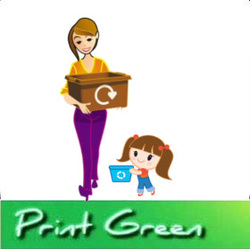 Why do we have to choose recycled products, and why do we have to use them? To narrow our today's topic, let's focus on tackling about recycled consumables and commodities from the print industry. Printers are now a common equipment to most houses, offices and businesses. Mainly because in our today's professional lifestyle printing became a necessity. Also, the market value of printers notably dropped that you can even purchased a new one as much as you can replace your mobile phone.Now how is it related to the question "why must we use recycled products"? Let me try to explain it as brief as possible. Printers in order to work, requires ink or toner cartridges. Once its consumables run out of ink or toner, the user will have to replace it as soon as possible or else the machine won't work properly. If you buy a printer today, it's common that it includes a set of cartridges, which as not everyone knows that these "free trial" cartridges contain less than half full of inks or toners. Eventually the printer will soon run out of inks with just a few prints, in short you have to purchase a new set of replacements. The process goes on and on, the cartridges will get empty then again you will buy replacement. Without you even noticing it, the cost is inclining year after year, as well as the accumulated wastes from empty and used ink tanks. Guess you probably get an answer to our question. If we will only use brand new printer consumables, in the end, resources, energy and supplies will only get scarce until there's no more left for us to manufacture. But through using recycled products, we are extending the span and usage limit of a material, hence we're giving them new life. Recycled printer consumables or commonly called as remanufactured toner cartridges and ink cartridges are one of the available solutions that we can embrace. Indeed we can get a lot of saving when we opt for these products, but let's not close our minds to such reason, regardless that we cut down printing expense or not, the essence of using recycled cartridges is mainly to preserve and protect our environment. Aside from remanufactured cartridges, there are recycled paper materials that we could use as an alternative. You might as well like to read this post about Recycled Toner Cartridges and Ink Cartridges.
With the strikingly high prices of OEM printer consumables in the market, no wonder why most customers are opting for the alternatives and making a switch. Some were trying it as a temporary solution on their mounting printing expenses just to give it a cut, and eventually they end up liking the product, thus using it for good. Breaking the category of printer cartridges into two such as the OEM (original equipment manufactured) and the non-OEM (remanufactured by third party). Are you also familiar to the two types of non-OEM? These are the compatible and remanufactured cartridges, either ink or toner, it applies to both. How can we differentiate one from the other, or should we say is there such a difference between these two products? Let's try to find out by giving you guys a brief description about these third party printer consumables. Starting with the remanufactured cartridges, as I myself use it with most of my printers at work. Not everyone who uses it knows that they are actually made from worn out or rather used tanks of original cartridges. For example, if you've got a lot of empty Lexmark toner cartridges or ink cartridges, you can send them out to your respective manufacturer for recycling purposes. That's right, just like any other plastic bottles out there, toner and ink cartridges are also recycled, thus producing remanufactured cartridges. Why are they cheaper if it's also made from original materials? Simply because, it doesn't require them to use virgin materials for the production, instead they utilize those returned cartridges from their customers, saving them time, money and energy. Now with the compatibles, these are literally third party products. Although they not substandard, I mean it depends on the quality testing they run. Anyhow, unlike with remanufactured cartridges, compatibles are brand new printer cartridges, but not branded. Manufactured on a different process over OEMs, yet still they work and function the same way as branded cartridges do. Whilst it provides similar benefits like remanufactured, which is to give savings to all consumers. However, if we're talking about which is more environment friendly, I'd still go for the remanufactured toner cartridges and ink cartridges, since they're made from use materials instead of new resources. Occasional errors and print failures is inevitable, whatever type of cartridges you're using, believe me, any remanufactured or compatible cartridge may lead to print problems as much as OEM products might cause. So which one is more preferable on your choice? Regardless of what type you choose, or you would still like to stick with the OEM, please do recycle your printer cartridges as much as possible, to protect the environment.
Anyone who knows Hong Yi? Well, she's a mixed media artist, commonly known as "Red", she can use anything as her medium to create wonderful art works. Featuring her on our blog was truly an awesome treat for all my readers, so without further adieu here's her new masterpiece. It all started when Red accepted HP's challenge to her by using an HP printer, a single ink cartridge particularly the one that comes from Ink Advantage series, and a pack of A4 plain papers about 1500 sheets. HP was so excited just like all the other people waiting for her creation, and after Red was finally done with her project, everyone was startled with the elegance and simplicity of an astonishing portrait entitled "The Soaring Bird". It was all made through scanning real feathers using the HP Deskjet Ink Advantage 2520HC printer equipped with a single ink cartridge, and printed the scanned images to almost 1500 paper sheets. With all those thousands of printed pages, laying them out on the floor and playing with it just like a jigsaw puzzle, requires a lot of patience and of course talent. Using stuffs that we regularly use everyday, whether in the office or at home, who would have thought that with just a big creative idea, one could make an astounding work of art. Red's artistic view was truly amazing, I wish I could have the same talent and bright ideas just like her. HP was so proud to say that Red doesn't encounter any paper jams or clogged print heads while doing all the process of scanning and printing those images. It's like she gave the device a new purpose, that it can't only be use just for printing our office files and documents, school projects, and many more. Honestly it was a noble idea and I commend her a lot for doing such a great job. Now I'm wondering what to do with my printer later, maybe I'll start first with thinking what portrait should I make. I'm thinking if my printer is ready enough to face my challenge, guess I need to go downtown for some replacement cartridges. Though we are using remanufactured toner cartridges and ink cartridges, I don't think it would matter, as it can match up with OEM products. Got interested to Hong Yi? Visit her official website to see more of her wonderful jaw dropping works of art : redhongyi
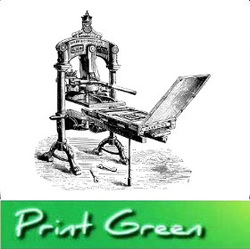 Along with the holy week season, PrintGreen will be dedicating a post for this special occasion. Although not everyone may be commemorating the week of the Lord's Passion, and it's actually not complaisant, I would still like to commit. Still related to the print industry, let's start our story. Giving credits to our post's main cast, the great Johan Gutenberg, a German goldsmith who first invented and introduced the printing press to Europe. He started the Printing Revolution around the year of 1439, mostly in European countries. His invention played much essence not only in the modern period, it also brought the emergence of none-hand-written books for the masses. Here's a great historical fact with regards to his invention. The first ever book that was printed using printing press was none other than, the Holy Bible. It was at the same year, around 1450, when Gutenberg was given credit for his invention, when the first batch of the book of the Holy Bible was completed. According to historians, there were about 230 printed copies from which 30 of those were printed on animal skins, while the rest were printed on paper made from rag cotton pulp. From then on, printing technology spread from Mainz Germany to all the cities in Europe, and all throughout the world. Although such devices before were totally big and bulky, compared to our modern day laser printers and inkjet printers, it is undoubtedly a remarkable start of the printing technology. Talking about our today's printers, we got tough, elegant-looking, multifunctional laser and ink type printers, but none of them makes a remarkably peculiar mark in the history. Maybe I have never heard of it, if there's any. But using our high-end printer equipments today, we can make a phenomenal printed version of the Holy Bible, considering the wide selection of cartridges available in the market. We can also use eco friendly toner cartridges and ink cartridges together with recycled paper materials, and covered it with dried animal skins perhaps. That sounds like a new generation of Johan Gutenberg's Holy Bible book.
First, what are these recycled toner cartridges?I think this question shouldn't be asked again and again, since the name of this product explains everything regarding this top question. But for those who are still asking, they are made from recycled components OEM cartridges returned by most consumers. Inspected, cleaned, refurbished and refilled with new inks or toners. What are the processes involved in the recycling process?Actually the processes may vary from one manufacturer to another. But generally speaking, and like I said, it involves testing of the returned components, thorough cleaning or refurbishing, damage part replacement, refilling of new inks or toners, and packaging. On top of all these processes, quality assurance is always the priority. How would you rate their performance and productivity?This one will take a long argumentation if we really go through all the details, so I'll try to limit it as necessary. Depending on where you bought the product, it can potentially affect the quality of the cartridges. Faulty cartridges is a problem that you may not only encounter with recycled cartridges, even OEM products can be faulty or damaged. Productivity-wise, there were customer feedback claiming that recycled toner cartridges and ink cartridges when compared to OEMs can be a well matched. So yes, they indeed perform equally with high-priced printer cartridges. Does it also affect the environment much like the OEMs?Yes, it affects ecologically but in a very positive sense, and no, because they don't do much harm as OEM consumables can negatively impact the environment. Through recycling, materials and resources are effectively conserved and reused, hence it supports sustainability. An OEM cartridge that thoroughly passed the quality standards of print industry, can be recycled three or more times, conserving million pounds of petroleum resources. Will it void my printers warranty?Absolutely no, especially those who are 100% US-made recycled cartridges. If you're worrying about the cartridge sensor installed in your printer, remanufacturers also replace the sensor chip embedded on each of their products, thus your won't get any problem with your printer not detecting the replacement cartridge. Not unless it is really a faulty cartridge, but again such problems may also happen with OEMs. Does using such products will damage my printer?Let me ask you this, haven't you experienced print failures, paper jams, and other common printer problems with your printer while using OEM cartridges? If yes, then more likely you'll get the same head-spinning problems when you switch for recycled cartridges, it's inevitable. Besides these recycled products are still made from OEM components, so you can still consider it good as new.
Monitoring the cost of printing can sometimes become a head-spinning task, not only because it's a bit troublesome to track the expenses, but also the figures you'll see after summing up all the cost. Let alone the personal printers, as the cost it takes to run a personal home printer is way cheaper than running an office printer. Even for small-type businesses that relies heavily on printing, they can accumulate thousands of cost in printing expenses just for a month alone. What can we do to cut down our cost of printing? If there's a will there's a way right, so better think first that you eagerly want to reduce your expense, and you'll see solutions will pop up from nowhere. Actually, whether you are the boss or just an employee, there are ways from which your office can greatly benefit on reducing printer expenses. First, in any case let them know that they're actually wasting or not utilizing properly their resources particularly the office supplies. Of-course try to explain the matter on them in a humane manner. Remember that you're trying to let them realize what bad habits should be put into an end, and what are the proper things that should be implemented. Paper materials, energy, as well as the inks/toners that are being consumed in the printing process must be conserve. Now after the preaching part, give emphasis on the benefits of leaning towards green printing practices. Next, monitor your subordinates. All the explaining and preaching will be worthless if nobody absorbs it. Monitoring your employees behavior and practices is normal, that wouldn't be against any law. See if they really apply what you have told them previously, and that they're gradually improving on practicing green printing. Also, it would help if you try to limit the resources in the office storage rooms, so your employees would think of a way to fit in on what is available. Another thing to consider is by setting your printer into Eco-mode, I'm not sure if every model of printer in market nowadays supports the said feature, probably there's a great number but not all. Setting your office printer into this mode will let you save toners and inks in the long run, thus cutting down the cost of printing. Have you tried using alternatives? Compatible or remanufactured, whatever you call it, these are recycled toner cartridges and ink cartridges from third party retailers. There's a common notion that people thought of recycled products are substandard, well they're wrong, over the recent years alternative cartridges have improved in terms of sales and demands. The quality of these eco-friendly printer cartridges are certainly of par with their counterparts, and that isn't surprising. There are so many ways worth considering to reduce your office and printing expenses. Provided that you already know these solutions and tips, implementing and practicing them would be the essential part. But it's always never too late to change what you've been accustomed especially it will make things better.
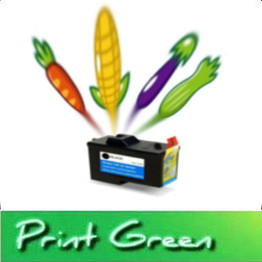 Choose what's best, it's just too easy to say yet kinda hard too do, especially if there's so much option in front of you. Once you determine what's more appropriate and suitable, it's either you'll start with the right one or you'll realize you just started using the wrong choice. But there's always a chance to make a switch. The chance to switch for a better purpose is indeed fulfilling, and one thing we could change is our choice of what products to use. There are cheap merchandises in the market and there are also these expensive and branded products. Does it really mean that high-price means high-quality? For a wise consumer, quality shouldn't be compromised even if you're opting for lower priced products. In our everyday printing, the inks or toners we used, are we really using the good choice? A typical printer cartridge is mainly made from petroleum-based materials. Indeed there are these bio-based printer consumables available, but they're not yet widely known, even their ecological impacts on the environment as well as to us.Conventional printer ink and toner cartridges use pigments and other metal substances which may bring harmful effects when people get exposed to it. Also, these consumables are mainly made of non-renewable resources. Aside from the fact that they're not renewable, the cost and energy requirement to accumulate such substances and materials are extremely high. Whereas bio-based printer cartridges, due to the shortage of oil products, they emerge and became an alternative printer consumable. It's also been said that vegetable-based inks can deliver much better performance over conventional inks, or even to soy-based ink products. In addition, the emission of Volatile Organic Compound has been greatly reduced. Bio-based inks are also efficient for recycling process, although conventional ink cartridges can also be recycled, the latter requires more energy in the re-manufacturing process. But re-manufacturers should be mindful of the limit from which a typical cartridge can be reused, more likely it's about 4-5 times a cartridge can be recycled. From a consumers point of view, cost is something they really look in to, it's actually one of the reason why recycled toner cartridges and ink cartridges are being supported ever since they emerged. If you're running a business, consider these information and the option to make a switch to a better and greener printing practices, it's actually a great move. Benefits and advantages will come along the way if you tried switching to recycled printer cartridges and office supplies. Don't focus on how much you can save that's why you are switching, think of the environment and how you can save it as well as your health.
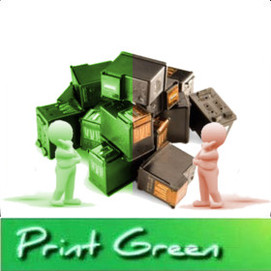 According to EarthShare, back in 2010, each year there were 400,000 tons of plastic and metal materials are being saved from ending into landfills through recycling printer cartridges. Imagine that huge amount, tons and tons of used toner and ink cartridges are being discarded each and every year, and most people doesn't even care whatever the result maybe from throwing away these materials. Just so you know, aside from reusing the materials particularly the components of printer cartridges for manufacturing new cartridges, they don't just save the resources, they also save energy by less than 50% simply recycling printer consumables. Oil and petroleum are two of the most essential materials that are use in the production of ink and toner cartridges, if you think there's more of it to consume, then you better think again. Let's make an assumption, say each day there are more than a hundred pieces of cartridges that are thrown away in a single state. Now, imagine if you multiple those hundred pieces by 365 days, roughly we get 36,500 pieces, not too much at it seems. But it's just for a single states alone, how many states do we have in the U.S. about 50 or more right, then that will give you a figure that would reach millions. For a fact, more than 90% of all the components and materials a cartridge composed of can either be recycled or reuse. If I'm not mistaken, I think a cartridge can be recycled for more than four times, from which it will reach its limit. Considering these facts, it is quite surprising to see drastic improvements in the production of recycled toner cartridges in the market, and how consumers are supporting such products over the years. A commitment to go green not only with our printing practices is something that we should take seriously. By giving a second-life to these recyclable materials, we tend to save the environment as well as our pockets from the mounting expenses that we printer users accumulate every year. By opting for recycled printer cartridges and office supplies, we became environmentally responsible and a wise consumer as well. Remember that we don't have to spend too much just to have the excellent quality and performance that we demand. Certainly, there are ways from which we can save more while getting the quality we deserve without risking our environment.
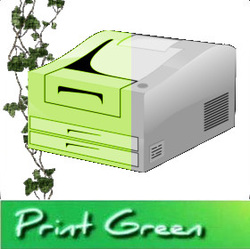 How can your printing practices be environmentally beneficial? Do you at least consider green printing? If so, how efficient are your practices in terms of being responsible for the environment? These are just some of the questions that you can ask to yourself whenever your print, whether it is in the office, at your house, or any other place where you can actually print. Aside from the fact that you can save much money in the process, there are tips and guides that you can utilize to create a positive impact for the environment through green printing practices. Does you printer supports Duplex (double-sided) printing? If yes, you probably noticed a decrease with your printer's paper usage. It can nearly reduce the figures by half, hence you cut down the expense of purchasing packs of paper materials while eliminating much paper waste as well. Most printer nowadays were built with an eco-friendly mode or setting wherein you can set the printer to its lowest ink consumption. Of course there's always an exception to these settings, such as files and business documents that require the highest possible print resolution a printer can provide. But for not so important files, you can switch your printer to Eco mode to save the remaining inks or toners. Are you familiar with the blue Energy Star label that can be found in most equipments and electronic products? If yes, then you might as well know what it serves for, it indicates effective usage of energy. If you want to go shopping for a new printer, consider checking the blue label or at least ask how efficient the printer can be in terms of power consumption. Now this suggestion can be a bit costly but considering the savings you can accumulate in the long run, you'll probably think over of it, this is applicable for offices and businesses. Do you print in black most of the time like about 80% of your prints can be done with a monochrome printer. Then it would be better to have a monochrome printer and a color type printer as well, so instead of making black prints with a color printer, you can send all those files to the mono type. Why do you need to have both printer? Monochrome printers only used a single toner cartridge, whereas a color printer has more than four cartridges. In addition, you can equipped a mono printer with high-yield cartridges or recycled toner cartridges to save more on your printing expense.
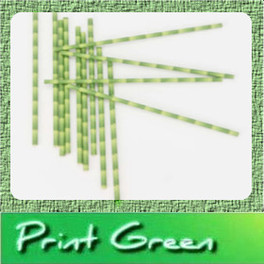 Straw materials are typically made out of plastic components, one good example would be drinking straws, which we often use to sip and enjoy the beverages we drink everyday. Though we don't get to use drinking straws everyday, like with coffee, you don't have to use a straw to drink it unless it's an ice coffee, nonetheless you can use a straw. There are other straw products aside from the one we use to sip a cold beverage. But instead of enumerating those, more than anything else, we should be talking about the material these products were made. Plastic, such a material used to produce different products, yet it tends to leave negative impacts on the environment. Although there were innovations that changed the industry by developing alternative materials from which we can substitute to plastic use. Through those inventions, the use of plastic materials have been reduced over the past years. Substituted by environment friendly, degradable materials that can be utilize as an alternative consumable in place of plastic. As an addition to those plastic alternative materials, here's the Birch and Bamboo Paper Straws that let you experience the way you get used to drink your beverages while being eco-friendly at the same time. It has been described as, "Eco-friendly straws that are made of paper, and have been wax-coated. The unique birch and, bamboo wood patterns have been created using a soy-based ink. These paper straws are a fantastic green alternative to the mainstream plastic variety that are often harmful to the environment."Helping the environment while having fun drinking with a unique straw, what a great way to enjoy your beverages. And to have a more greener life style, try using recycled products and consumables as your alternative daily supplies. Include on your list these eco-friendly toner cartridges and ink cartridges as your printer consumables for a greener and better way of printing.
|






 RSS Feed
RSS Feed